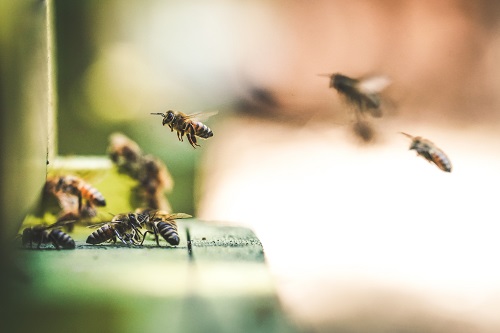7 Flowering Trees for Warm and Coastal Weather
When we think of trees that grow on the coastal line, we think of palms and coconut trees. But we are going to be particularly talking about some of the most beautiful flowering trees in the world that love warm temperatures, full sun exposure, and humid air. Yes, we are talking about flowering trees that grow in warm and coastal weather!
These are some sturdy trees that take up such conditions for growing, yet they bear the most delicate and gorgeous-looking blooms. These blooms have the world’s attention and their blooming season is one of the most well-known.
Here is a list of the flowering trees that grow in warm and coastal weather. You might be familiar with some and not-so-familiar with others. It’s time to get up close and personal with these trees.
1. Cherry Blossom
Cherry blossom is a subtropical tree that has a very short-lived bloom time. It symbolizes renewal as it marks the beginning of spring (the season of regrowth). Cherry blossom has a lot of species and the most well-known is Sakura or Japanese cherry blossom. Cherry blossoms are deciduous trees that grow in different sizes. They are one of the most loved flowering trees for their stunning pink and white flowers.
Did You Know: Cherry blossom petals are edible and used in Japanese herbal teas and desserts.
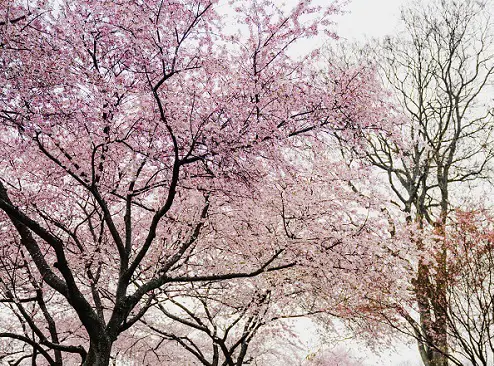
Care:
Cherry blossom needs full sun and a very rich fertile soil to thrive. Make sure the soil is well-drained. Do not overwater this tree. It is very much susceptible to pest infestation. They need full sun exposure. Six hours of direct sunlight every day should be ample for them.
Height:
A flowering cherry blossom tree can take up a lot of space in your yard as it can grow up to 15 to 30 feet high and equally wide.
Bloom Time:
The arrival of cherry blossom blooms and spring go hand in hand or vice versa. In fact, there are special events organized for the viewing of these breathtakingly beautiful flowering trees.
Fulfill your dream of birdwatching every morning with this complete guide to attract birds to your backyard, fast!
2. Flowering Dogwood
The flowering dogwood is an ornamental tree that bears white, pink, or red flowers. This tree has both male and female parts and can self-pollinate. This majestic flowering tree can be found in coastal areas and warmer regions. Flowering dogwood has oval-shaped leaves and bears a reddish-yellow fruit. The young tree has a distinctly unpleasant smell, but once it grows it will amaze you with splendor and magnanimity.
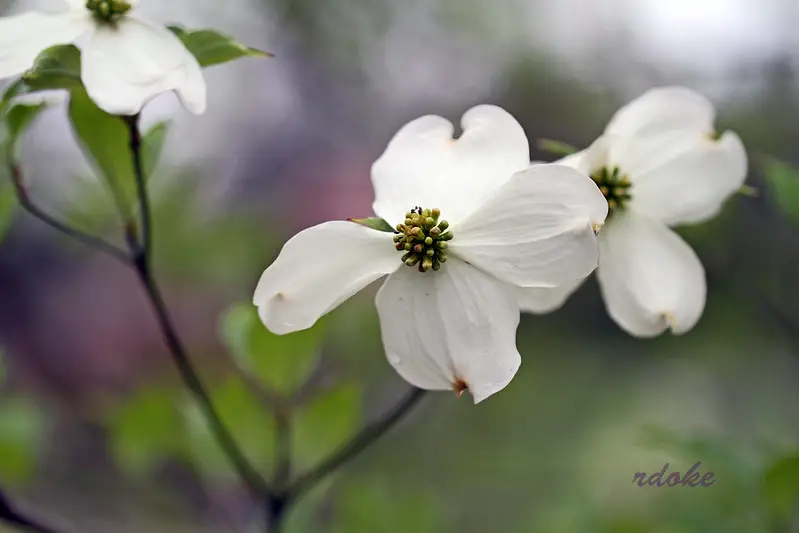
Care:
They require regular watering once a week but in summers or dry spells water them more to keep the blooms fresh and not wilting. They require full sun for at least 4 hours a day. Although the mature trees do not need much fertilizing, you can fertilize the young ones with small amounts of slow-release formulas. Just give them well-drained but moist soil and they will be a happy one!
Height:
The average height of this tree is about 30 feet high. If you are growing the tree in your yard, we suggest pruning the dead leaves and barks in late winters so that it makes space for the fresher ones that will come out in spring.
Bloom Time:
The gorgeous flowers bloom in springtime.
3. Crape Myrtle
Remember the tree with watermelon-y soft blossoms growing in clusters? Yes, we are talking about crape myrtle here. The tree bears flowers in a variety of colors but somehow the pink color seems to have made a mark as its identity. An all-year rounder tree that comes in so many sizes, this tree or shrub could be the focal point of your garden. But wait, these flowering trees grow best in warm or coastal areas. So check the hardiness of the area you live in before planting them.
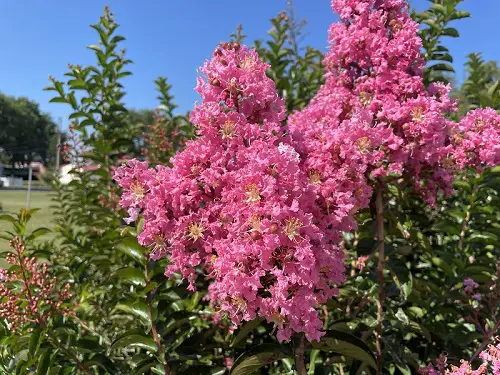
Care:
Give them full sun for at least six full hours and they will reward you with the prettiest of the flowers. They like humid temperatures and once fully matured, they can tolerate slight drought. Water once a week in dormancy period, otherwise, they like ample watering (5 times a week would be a good choice). Crape myrtle is not fussy about the soil choice as long as the soil is moist and well-drained.
Height:
It’s a very versatile tree when it comes to size. It can be grown as a shrub and can be grown as a full-blown tree. The choice is yours completely. The dwarf variety grows till 4 feet high. A semi-dwarf can go up to 8 feet high. You can prune the tree branches to adjust the size according to your space.
Bloom Time:
It is suggested to plant crape myrtle during the winter season when it is dormant and it will bloom from late spring to summer.
Enhance the beauty of your garden with this article on keeping your garden accessories safe and last for a long time.
4. Magnolia
Magnolias are your sweet fragrant, statement-flowered trees that usually grow in the southern region. The magnificent, waxy white or pink flower and their fragrance will make your yard the talk of the neighborhood. Even the waxy dark green foliage is a thing of beauty that is evergreen. The tree bears cone-like fruit that attracts songbirds. These trees are resistant to pest infestation as well.

Care:
Magnolias are resilient trees that can take harsh summers and are moderately drought tolerant. However, we suggest watering young plants regularly until they have fully grown. Although they don’t like wet feet, keep the soil moist and well-drained. They love the humid weather.
Height:
Magnolias can be restricted to a size of a shrub that grows up to 8 feet high if pruned well. Otherwise, a full-blown magnolia tree can reach a whopping size of 70 feet high.
Bloom Time:
The best time for magnolias to bloom is in early spring. The evergreen varieties bloom throughout.
5. Redbud
A relatively fast-growing tree that will start flowering in its third year of growth, redbud is commonly used for ornamental and landscaping purposes in yards in warmer regions. In spring the mauve flowers will greet you with their stunning beauty lasting for two to three weeks. Redbud is not considered a big tree because of its size. The main bark divides closer to the ground.
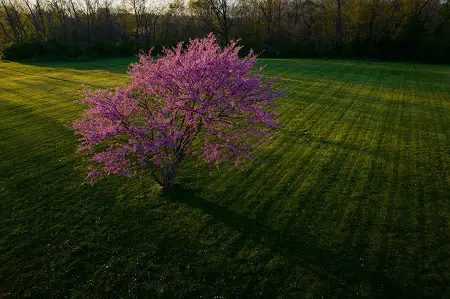
Care:
Redbud loves basking in the full sun although will do fine in partial shade as well. They are adaptable and can thrive well in acidic as well as alkaline soil. Do not plant them where they feel claustrophobic as that may result in pest or fungal infection.
Height:
An average height of 20 to 30 feet is common in redbud trees. When fully matured, it spreads at the same width.
Bloom Time:
The tree blooms beautiful flowers in spring. Prune the dead leaves and branches in the fall to maintain the size and beauty and for a healthier plant.
6. Forsythia
Forsythia is deciduous, fast-growing shrub that belongs to the olive family. They are commonly known for their long thin branches that get covered with outstanding yellow flowers. You’ll more commonly know them as golden bells. One drawback of having this shrub in your yard is that it grows exponentially and becomes quite invasive while taking up the growing space of other plants in your yard. Forsythia is a warm region shrub that loves it when the temperatures are between 55 to 70 degrees Fahrenheit. They love mild humidity. Too much moisture will make the flowers wilt.
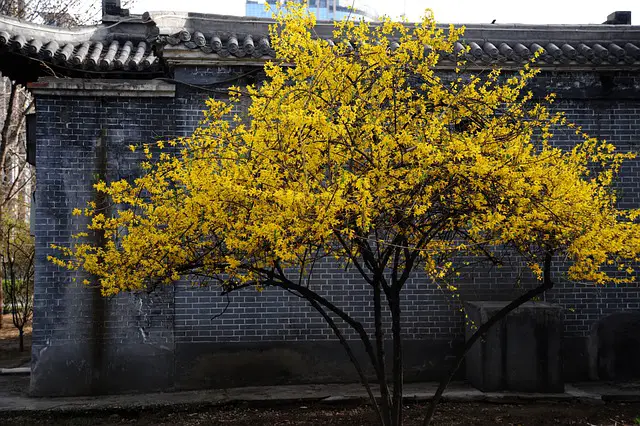
Care:
If you want a lush flower bloom, give your forsythia bush a full sun exposure of 4 to 6 hours. It can tolerate part shade but it will not be as rewarding. Well-drained and moist soil will do well for the tree.
Height:
It can grow up to the height of 2 to 10 feet high and has an equally big widespread.
Bloom Time:
They are perfect for your landscaping needs with their yellow flowers that bloom in early spring. In fall, the foliage turns yellowish-orange. Pruning shrubs immediately after the flowering time finishes will give it more space for the fresh flowers buds to appear.
Increase the lifespan and make the most out of them with these useful tips to take care of your outdoor furniture.
7. Jacaranda
These flowering shrubs and trees are usually found in the subtropical parts of the world. Jacaranda trees are the perfect definition of elegance with the combination of their signature purple flowers and showy leaves. This tree is usually grown in greenhouses to provide the warm temperature they require. It is a fast-growing plant that can become quite invasive, taking up the growing space of the surrounding plants and trees. The flowering season is very brief for Jacaranda. It has very sweet-smelling flowers but once they are fallen off and decomposed, they smell pungent and rotten.
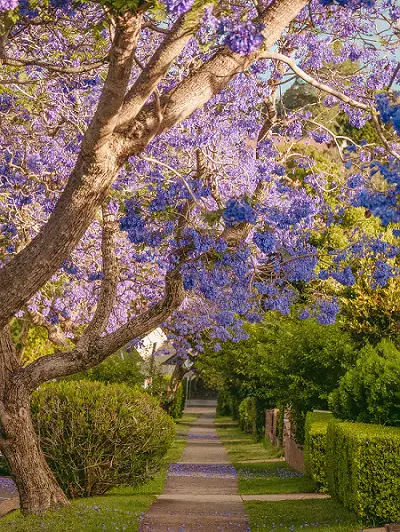
Care:
Water this plant deeply. The leaves will start turning yellow if it is dehydrated. Water the plant especially well on hot days. Jacaranda loves full sun and lacks vibrancy in its flowers if it doesn’t get enough sun. They like well-drained, acidic, and sandy soil. These trees don’t like wet feet as it can result in root rot.
Height:
This deciduous and ever-green plant can grow up to 5 to 15 meters tall.
Bloom Time:
Jacaranda blooms twice a year. First, it blooms from late spring to midsummer and the second bloom is in the fall which begins early to mid-October. That means it starts flowering in late fall.
The beautiful flowering trees that grow up near the coasts are in fact something special. These soak up the hot sun with sandy soil in their feet and the salty breeze blowing through their foliage. No wonder they are one of the most gorgeous trees in the world. If you are lucky enough to provide them with the TLC they need, you might end up growing them in your own yard!

